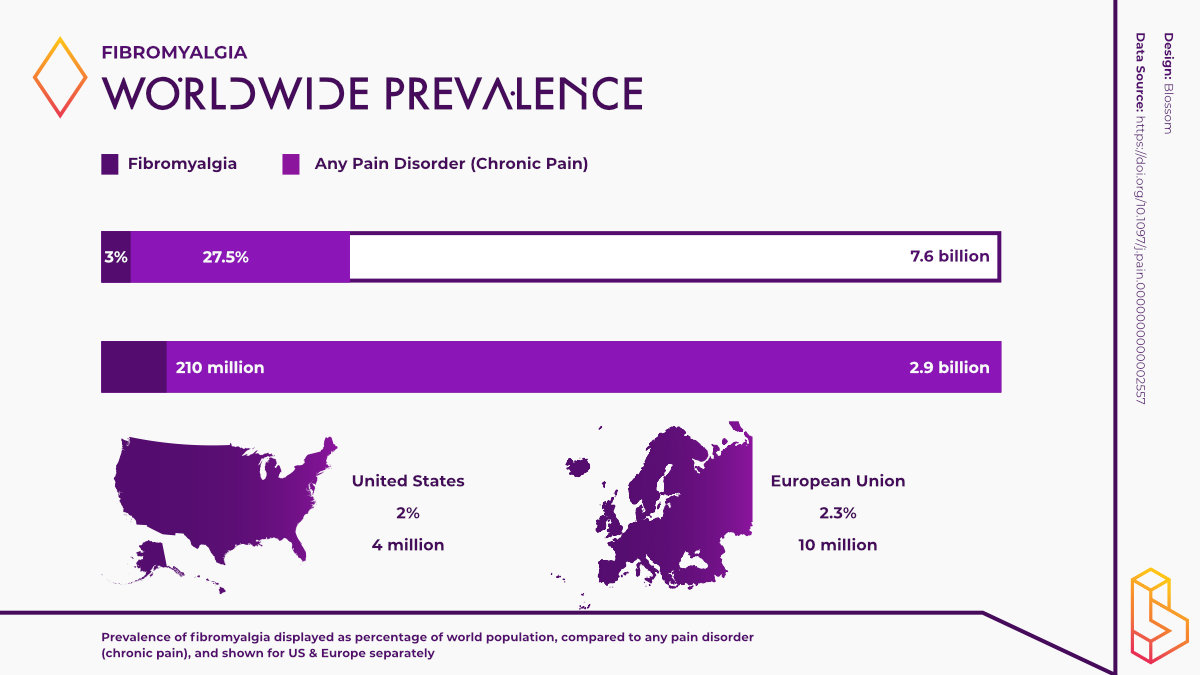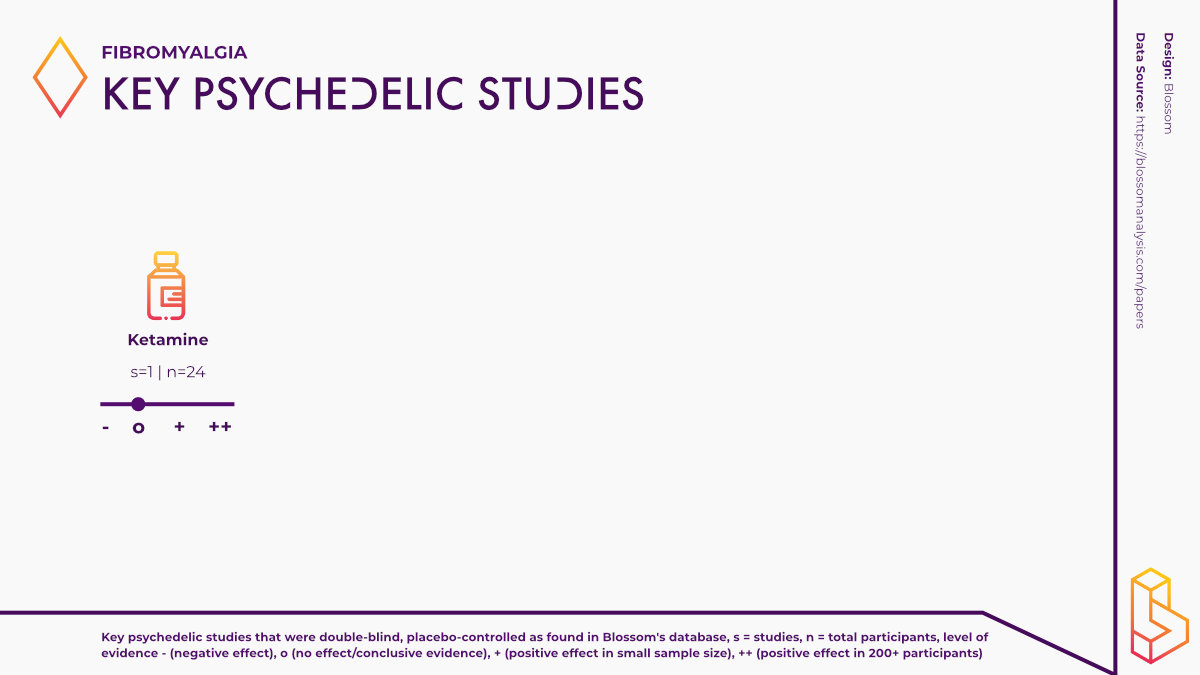Effect Matrix of Psychedelics for Fibromyalgia
What is Fibromyalgia?
Fibromyalgia is a complex and misunderstood medical condition characterized by chronic widespread pain, fatigue, sleep disturbances, cognitive symptoms, and other issues such as depression, insomnia, and hypersensitivity. This condition affects 2-4% of the population, with women being impacted more frequently than men at a ratio of 1:7 (in clinical populations). According to twin studies, widespread chronic pain has been found to have a heritability rate of around 50% [1].
The exact cause of fibromyalgia remains unknown, but it is believed to involve a combination of genetic and environmental factors. Current research suggests that the pain experienced by those with fibromyalgia results from processes within the central nervous system, leading to the classification of the condition as a “central sensitization syndrome”.
The economic impact of fibromyalgia is significant, leading to considerable lost productivity and impairment costs for society. People who suffer from fibromyalgia require extensive healthcare services, like patients with diabetes mellitus and hypertension. Typically, individuals with fibromyalgia visit outpatient medical facilities around ten times annually on average [1].
The psychological burden of fibromyalgia is high, with 25 to 65% reporting depression and anxiety [2]. Fibromyalgia frequently co-occurs with other chronic symptomatic conditions that may share similar central mechanisms, including chronic back pain, irritable bowel syndrome, and temporomandibular disorders.
Although there is no definitive cure for fibromyalgia, various treatment options are available to help manage symptoms. These include aerobic and strengthening exercises, mindfulness, psychotherapy, and alternative therapies such as acupuncture and meditative exercises like qigong, yoga, and tai chi. The use of medications in treating fibromyalgia is debated. Still, certain antidepressants, non-steroidal anti-inflammatory drugs (NSAIDs), and muscle relaxants have been found to improve the quality of life for some patients. Additionally, the FDA has approved medications such as duloxetine, milnacipran, and pregabalin for managing fibromyalgia [3].

Psychedelics and Fibromyalgia
In the area of pain, not much is known about how psychedelics work and for whom. Several survey studies generally show positive attitudes towards psychedelics. Specifically for fibromyalgia, Nicolas Glynos and colleagues asked those with fibromyalgia about their experience with psychedelics. About a third (100 participants) had used psychedelics in the past. Of those who had used psychedelics whilst experiencing chronic pain, 37% reported benefits, 59% were neutral, and 3% negatively impacted pain or overall health.
The study identified a significant interest among participants in psychedelic-based treatments for chronic pain. Despite limited self-reported knowledge of psychedelics, most participants were aware of ongoing research into their therapeutic potential, and were open to participating in a psychedelic-based clinical trial for their pain.
Julia Bornemann and colleagues at the Centre for Psychedelic Research at Imperial College London looked more specifically at the experiences of those self-medicating with psychedelics for chronic pain in preparation for a clinical trial. In the interview study, 11 people living with chronic pain who self-medicate with psychedelic drugs were interviewed to understand their therapeutic protocols and practices.
The participants reported improved pain scores during and after psychedelic experiences, with psychedelics such as psilocybin-containing mushrooms often used. Techniques such as Positive Reframing (journey from pain catastrophising towards acceptance and empowerment) and Somatic Presence (renewed mindfulness of physical experiences and physical catharsis.), along with mindfulness, breathwork, and movement, played a crucial role in enhancing well-being and reducing pain. However, due to the subjective nature of the data, the study does not claim causality or generalizability. This pre-trial study is being used to design a controlled trial on the efficacy of psychedelic therapy for chronic pain.
The study also showed substantial variations in substances, doses, frequency of use, and longevity of effects. Most participants reported reductions in pain scores during and after psychedelic experiences, and all noticed a gradual return to baseline pain levels over a period of two to five days.
Qualitatively the best study, a randomized controlled trial, of (es)ketamine failed to find improvements in fibromyalgia pain. The study investigated the effects of a single infusion of esketamine (35mg/70kg). It did find immediate benefits (right after infusion) but no differences versus placebo after 2.5 hours until the eight week follow-up. This study was conducted in 2011, with no other ketamine studies being done in the meantime.
A 2019 case study is the fourth and final study that looks specifically at psychedelics and fibromyalgia. It, retrospectively, describes the analgesic effects of repeated changa (smoking mixture which contained an unspecified amount of DMT) treatment administered to a 57-year-old male doctor who was suffering for ten years from chronic fatigue and persistent pain.
Following repeated changa treatments, the 57-year-old male participant experienced significant improvements in his condition. Beginning with the second session, he reported intense psychoactive effects and nearly complete pain relief for two weeks. With each subsequent session, the benefits persisted and expanded to include mood improvement, elimination of autolytic ideation, enhanced colour perception, greater emotional stability, and a slight decrease in fatigue. The pain relief effects sustained for up to 15 days after each session.
In conclusion, the potential therapeutic role of psychedelics for chronic pain and fibromyalgia is an emerging area of research that has shown promising preliminary results. Personal experiences and survey studies suggest that a significant proportion of individuals with chronic pain are already self-medicating with psychedelics and reporting benefits such as improdved pain scores and enhanced well-being. Despite the initial promising findings, it’s crucial to underline the need for controlled clinical trials to validate these results and establish safe, effective protocols for psychedelic use in treating chronic pain.

Upcoming Trials of Psychedelics for Fibromyalgia
Three clinical trials have started in 2022 to investigate the effect of psilocybin on fibromyalgia. At Imperial College London, the first brain measures will be taken to explore how two doses of psilocybin influence measures. In the United States, two more trials investigate what psilocybin can do for fibromyalgia. A trial at the University of Alabama at Birmingham will be the first double-blind study. Tryp Therapeutics has planned the first commercial study in partnership with the University of Michigan.
All trials hope to be concluded by the end of 2024 and will treat 70 participants.
How can psychedelics treat fibromyalgia?
A review by Joel Castellanos and colleagues, from 2020, reviewed the effects of psychedelics on chronic pain and proposed mechanisms of action. In the review, they acknowledge that the development of chronic pain, including fibromyalgia, is a complex process that is not yet fully understood. It is believed to be linked to the strengthening of certain neural circuits over time due to continuous pain signals, leading to both physical and emotional experiences of chronic pain. The mind-altering effects of psychedelics, attributed to their interaction with serotonin 2A (5-HT2A) receptors, are thought to reset areas of functional connectivity (FC) in the brain, which play crucial roles in many chronic pain conditions.
Psychedelics have a generally favourable safety profile, especially when compared to opioid analgesics, and some studies suggest potential analgesic benefits in treating various types of pain such as cancer pain, phantom limb pain, and cluster headaches. There are possible similarities between the 5-HT2A activation pathways of psychedelics and the nociceptive modulation pathways in humans, which might hint at how these substances can provide pain relief. The alterations in FC observed with psychedelic use might help reverse the changes in neural connections seen in chronic pain states.
Research has also looked at the downstream effects of psychedelics on gene expression and inflammatory responses. For instance, activation of 5-HT2A receptors has been found to increase the expression of several genes and to inhibit inflammatory pathways. These receptors also play a role in pain caused by nerve injury and may contribute to hyperalgesia and neuropathic pain.
Psychedelics are believed to disrupt established brain networks, extending local functional connections to become more global. This disruption may lead to the formation of new, healthier connections as the drug’s effects subside. It’s thought that this mechanism, combined with other therapeutic modalities, could reverse some of the neuroplastic changes associated with the transition from acute to chronic pain.
In conclusion, while our understanding of psychedelics and their mechanisms of action in treating chronic pain is still limited, the potential of these substances to provide analgesic benefits and possibly reverse the pathological changes in neural connections seen in chronic pain states is promising. However, more rigorous and controlled clinical trials are needed to understand their impact on chronic pain fully.
How can I use psychedelics to treat fibromyalgia?
Psychedelics, such as psilocybin and LSD, are currently being researched for their potential in treating various mental health and chronic pain conditions, including fibromyalgia. However, as of 2023, these substances are largely still considered illegal in many parts of the world, and their use is not officially approved for treating fibromyalgia or other pain conditions. It’s important to note that self-administration of these substances outside of a controlled research or therapeutic setting can be risky due to their potent psychoactive effects and the potential for adverse reactions.
The ongoing scientific research suggests that psychedelics, through their interaction with serotonin receptors (5-HT2A), may have the potential to “reset” certain neural pathways and help manage chronic pain conditions like fibromyalgia. Some research also indicates that these substances might help to reverse some of the neuroplastic changes associated with chronic pain.
However, the effects of psychedelics are complex and can vary widely between individuals. Also, these substances have powerful psychological effects and can occasionally lead to adverse reactions, particularly in individuals with pre-existing mental health conditions or those who take them in non-controlled settings.
One possibility is participating in a clinical trial if you’re interested in the potential use of psychedelics for fibromyalgia. Clinical trials allow treatment in a controlled, safe environment while contributing to the scientific understanding of these substances. Clinical trials studying psychedelics are monitored by medical professionals and are conducted following strict safety protocols. Still, it should be noted that only three trials are ongoing, with only one (in the United Kingdom) currently recruiting patients.
Put more bluntly, there are currently no legal (in most of the world) or well-researched ways of using psychedelics to treat fibromyalgia.
Psychedelic Industry and Fibromyalgia
In the evolving landscape of psychedelic therapeutics, Tryp Therapeutics, a pharmaceutical company specializing in psilocybin-based compounds for diseases with unmet medical needs, is currently the only company developing these substances for treating fibromyalgia.
In December 2021, the company announced that it had received approval from the U.S. Food and Drug Administration (FDA) to proceed with a Phase IIa clinical trial on fibromyalgia. Though they had planned the study to start in 2022, currently, the status still hasn’t been updated to recruiting.
External references for Fibromyalgia and Psychedelics
All resources available on Blossom are directly linked on this topic page. Find even more background about this topic with these external references.
- Bair, M. J., & Krebs, E. E. (2020). Fibromyalgia. Annals of internal medicine, 172(5), ITC33-ITC48. https://doi.org/10.7326/AITC202003030
- Løge-Hagen, J. S., Sæle, A., Juhl, C., Bech, P., Stenager, E., & Mellentin, A. (2019). Prevalence of depressive disorder among patients with fibromyalgia: Systematic review and meta-analysis. Journal of affective disorders, 245, 1098-1105. https://doi.org/10.1016/j.jad.2018.12.001
- Kia, S., & Choy, E. (2017). Update on treatment guideline in fibromyalgia syndrome with focus on pharmacology. Biomedicines, 5(2), 20. https://doi.org/10.3390/biomedicines5020020
Highlighted Institutes
These are the institutes, from companies to universities, who are working on Fibromyalgia.
Tryp Therapeutics
Tryp Therapeutics is a clinical stage drug development company developing psilocybin products for various diseases/disorders including fibromyalgia.
Highlighted People
These are some of the best-known people, from researchers to entrepreneurs, working on Fibromyalgia.
Linked Research Papers & Trials
Pro & Business members will be able to see all linked papers and trials directly on this topic page.
This information is still available for you by selecting Fibromyalgia on the Papers and Trials pages respectively.
See the information directly on this page with a paid membership.

